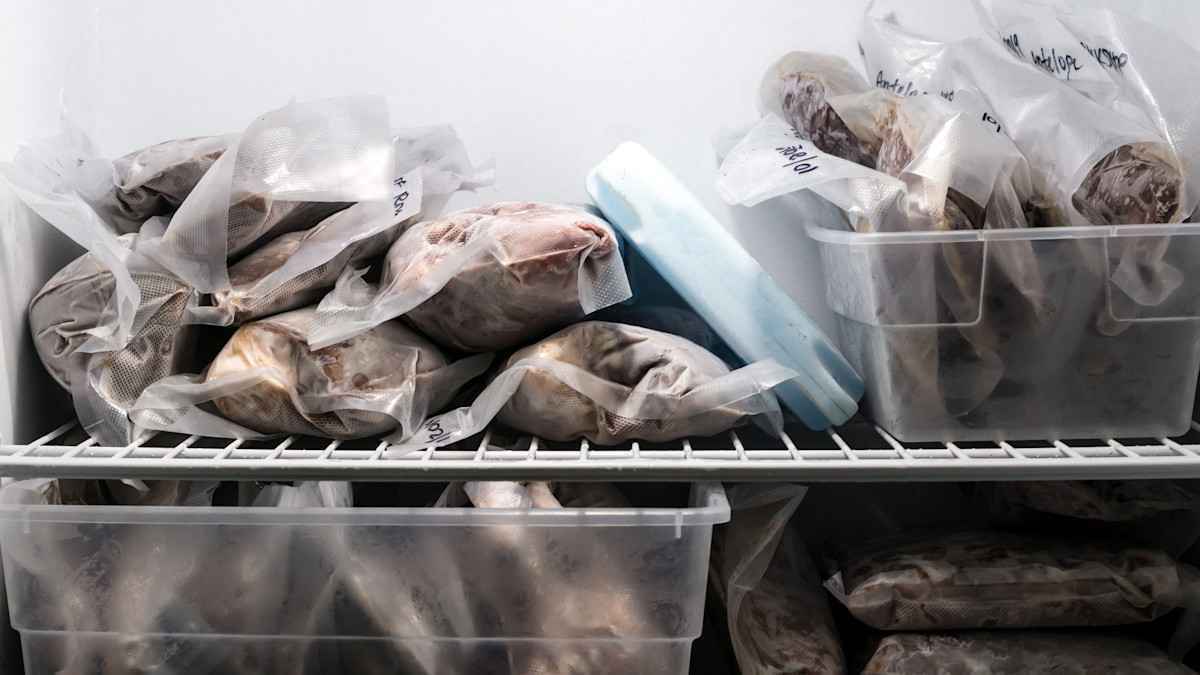
For hunters, freezers are perhaps some of our most valuable possessions. They preserve hard-earned meat and hold fond memories of time spent in the wild. Here are our best practices to ensure the meat inside remains as good as the day you harvested it.
How to Avoid Freezer Burn
Two things ruin meat: time and exposure to air. We’ve all had a run-in with that brown, leathery freezer burn layer. This occurs when ice crystals in the meat are able to evaporate, which ends up oxidizing or drying out the meat. Flavor, texture, and aroma suffer the consequences. While freezer burn isn’t an issue of food safety, it does make the meat taste worse. The best way to avoid it is by prevention.
Before freezing, completely cover the meat as tightly as possible with cling wrap or a vacuum sealer to prevent any air exposure. If you continue to get freezer burn, check the temperature of your freezer—it should be close to 0 degrees Fahrenheit. Leave a thermometer inside and check periodically to make sure there are no fluctuations.
Freezer Paper vs. Plastic
Deciding between paper or plastic for wrapping can be tricky. Butcher paper is a time-honored tradition for many folks. Today, almost all freezer paper comes lined with polyethylene plastic, not wax. Because paper alone won’t seal the air out, it’s best to double wrap by first placing the meat plastic wrap or Ziplock bags. This method is inexpensive, but the contents aren’t visible from the outside. If frost begins to develop, there’s no way of knowing until you defrost.
Vacuum sealing foods in plastic bags are a popular choice for good reason. Most commercially available bags have several layers of polyethylene and nylon that provide an excellent barrier for extending the shelf life. Also, the removal of oxygen mostly eliminates the risk of freezer burn, so long as that seal doesn’t break. Pin holes can develop surprisingly easily if you drop frozen packages on a hard floor or jostle them around. Still, many hunters and chefs consider vacuum sealing the best option for long-term storage. The downsides are that equipment and bags are expensive and some recycling centers do not accept this particular type of plastic.
The eco-friendliest option is to freeze meat in a container of water. This is especially popular and works particularly well with fish. The frozen water eliminates air exposure, but it will cause cell damage. If you find yourself in a pinch and none of these options are available, you can use aluminum foil instead.
How Long is Meat Good in the Freezer?
If wrapped carefully, venison should last in the freezer for a year at minimum, and two years if vacuum sealed. Fish and plucked birds don’t last nearly as long. Over time, the fat in these animals oxidizes and turns rancid. It’s best to eat fatty products, like waterfowl or sausages, sooner than later. I notice that quality slowly diminishes around three months for fish and six to nine months for waterfowl.
When processing, try to form flat packages, especially with ground meat. This allows the meat to freeze and defrost faster, as well as making the organization much more manageable. The longer it takes for meat to freeze, the more ice crystals form, causing cell damage and water loss. This type of damage is what happens when you re-freeze foods.
Be sure that there are no broken bones or fish spines inside the package before freezing. I’ve had several bags of waterfowl legs ruined because a sharp bone poked a hole in the bag.
You can also try freezing whole muscle groups with the outer tissue untrimmed. A layer of silverskin will act as a protective barrier around the meat and reduce air exposure.
Prevent Food Waste
Though it might seem obvious, make sure to label packages. No one likes “Mystery Meat Monday.” Labels provide dates that remind you to get through the previous year’s supply before tagging your next deer. Don’t keep piling up new meat on top of old meat.
If you defrost a package and find a little freezer-burn, there is some hope. You can salvage it by slicing off the outer layer that is damaged. Try cooking it in a recipe that calls for strong-flavored spices, such as a braised BBQ or gumbo.
Before the fall season begins, be sure to clean out the freezer of any old meat lurking around. When it comes time to process your next deer, make sure to eliminate any chance of air exposure to make sure it’s the best it can be when it comes time to eat.






